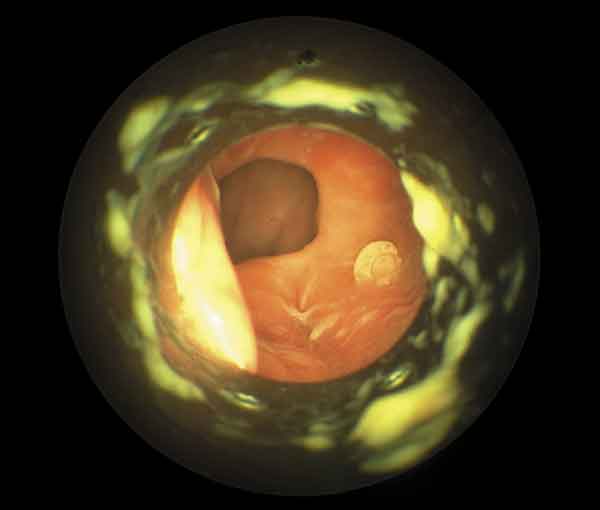Practice tip
Non refereed
Clinical techniques for detecting sows on heat
Mike J. Meredith, B Vet Med, MA, PhD, MRCVS
Pig Disease Information Centre, Lolworth, Cambridgeshire, CB3 8DS, UK
Practice Tips are not peer reviewed.
Over the years, a number of hand-held devices have been developed for detecting sows ready for service, on the basis of electrical conductivity changes in vaginal mucus. It's an attractive idea, particularly for AI or for anestrus investigations, so I have tested out a number of these simple aids over the years. They are no substitute for the ultimate test of providing contact with a boar, and, in my experience, they are not quite as reliable as a boar odor aerosol.
Field experience is supported by research1 into the "Walsmeta" instrument. Overall, a group of 44 sows showed significant changes in conductivity related to estrus and ovulation, but in individual cases, the measurements were unreliable. One problem is that the electrical resistance readings may be affected by urine contamination of the vaginal mucus. The results were moderately accurate if the sow had not urinated in the previous hour, but ensuring this is a serious practical limitation.
The instruments I have tested insert only as far as the vaginal vestibule (which is quite long in sows) and not as far as the cranial (cervical) vagina. This makes them reasonably safe from the hygiene point of view: this part of the vagina is flushed regularly with urine and is separated from the cervical vagina by a physiological sphincter, the vaginal ostium,2 which is closed except during estrus. Using an electrical device which inserts more deeply into the genital tract, like an AI catheter, would require a means for circumventing the risks of infection and trauma. Providing a disposable sterile sheath would not prevent the risk of introducing ascending infection.
Figure 1: Speculum view of the vestibule of a gilt in estrus, mated the previous day. Inner surface of speculum and floor of vestibule is coated with pale yellow, normal post-mating discharge. Piece of semen gel is on floor of vestibule, to right of slit-like urethral orifice. Directly ahead lies the dilated vaginal ostium, through which the dorsal wall of the vagina can be seen.

Copyright (C) 2001 Mike J. Meredith, used by permission
The clinical techniques for determining cycling and estrus that I have found most valuable, rectal palpation3 and speculum examination,4 were pioneered by Professor Bollwahn at the Hanover Veterinary School in the early 1970s. Real-time ultrasound scanning5 can yield additional detail about the nature and structure of ovarian and uterine contents. I have developed a simpler technique requiring less skill (though inevitably less accurate than the others). A sterile AI catheter is inserted into the vagina to gauge the penetrable length of the vagina and cervix at different stages of the estrus cycle.6 The penetrable (and actual) length of the sow's genital tract varies enormously in accordance with estrogen (shortening) or progesterone (lengthening) stimulation. Checking sows of known status with your catheter will enable you to set baseline parameters for penetration distance. Be sure to differentiate baseline data for gilts, uniparous sows, and multiparous sows. To minimize the risk of ascending infection in non-estrus sows, the catheter may be introduced into the vestibule via a sterile tube or speculum. This simple technique is especially useful for quickly checking gilts for cyclic activity.
Summary
- Clinical techniques for determining estrus are rarely as good as skilful use of a boar.
- An AI catheter may be used to determine if gilts are cycling.
- For infertility investigations, palpation and speculum techniques are indispensable.
References -- refereed
1. Stokhof SJH, Soede NM, Kemp B. Vaginal mucus conductivity as measured by the Walsmeta MKIV does not accurately predict the moment of ovulation or the optimum time for insemination in sows. Anim Repro Sci. 1996;41:305-310
3. Meredith MJ. Clinical examination of the ovaries and cervix of the sow. Vet Rec. 1977;101:70-74.
4. Meredith MJ. Clinical techniques for the examination of
infertile sows.
Proc Pig Vet Soc. 1981;8:49-53. Now called The Pig Journal.
Order on-line at: http://www.pigjournal.co.uk/orderrefs.htm
5. Meredith MJ, Maddock SJ. Porcine reproductive ultrasonography. In: Goddard PJ, ed. Veterinary Ultrasonography. Wallingford, Oxfordshire: CAB International; 1995:275-286.
6. Meredith MJ. Pig Breeding and Infertility. In: Meredith MJ. ed. Animal Breeding and Infertility. Oxford: Blackwell Science; 1995:278-353. Order on-line at: http://www.pighealth.com/MEDIA/P/ABI/ABANDI.HTM
References -- non refereed
2. Meredith MJ. Mating Injuries in Gilts. Proc IPVS. Mexico. 1982;210.
